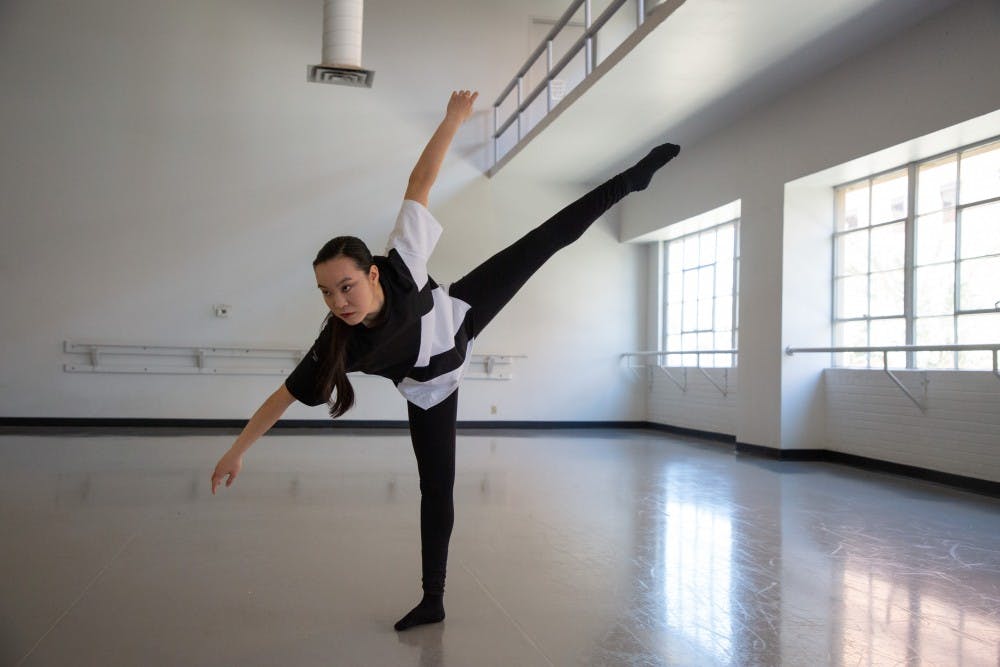A common assumption is that science and art are two totally different disciplines, and individuals are typically better at one or the other. ASU senior Courtney Ngai believes otherwise.
Ngai is an honors student majoring in computer science with a minor in dance. She said that people in her major are often surprised by her choice in minor and tell her the two subjects are so far removed.
“Are they really though?” she said is her response.
“When you’re programming you have blocks of code that you can write and then you can rearrange,” Ngai said. “I see the same thing happening for dance where with dance you can choreograph a set of moves and then you can choreograph another set of moves and then rearrange those also.”
Carley Conder, a full-time dance instructor in the School of Film, Dance and Theater, has worked closely with Ngai over her years in the program. She also runs her own dance company, CONDER Dance.
“I think dance is a way to — like any art form — to kind of frame or to look at the human experience so you can really have a point of view,” Conder said.
Conder also said Ngai has a unique perspective as a scientist, and that dance gives her the opportunity to express her point of view.
“She brings, kind of like this very measured, disciplined approach to everything that she does; which isn't always so common to dancers," Conder said.
In a solo project that Ngai is currently working on, she connects the use of improvisational dance to the structures found in coding — an idea which she has experimented with in a number of her projects.
“I really liked the freedom of improvisation just because it's a chance to be able to express yourself more, but also be able to be really aware of what is currently happening,” she said.
Even this abstract type of dancing has its ties to computer science, Ngai said.
“With structured improvisation, you have that framework and then you can follow the framework but still have the flexibility to move around within it," she said. "That’s the same with coding where you have a function but you can put different things in the function and get different outputs.”
The project, which is called “Do You Feel Empowered,” was inspired by her use of social media and the sense of passivity she said she feels when using social media apps.
“I go to Instagram and just start scrolling,” Ngai said. “I'm like, double tap. Oh that's cool. That's cool. That's cool. But I was like, what am I doing? I wanted to actually do something in my life rather than watch people do other things in their life.”
Ngai also pushed herself out of her comfort zone with the project by deciding to produce her own music, including recording her own voice for the track.
“I started getting into music production because I wanted to make my own music that I can dance to,” Ngai said. “I'd prefer to move more rather than speak, but I felt that to push myself also, I added in my voice."
Ngai started to notice the relationship between science and dance in her honor’s thesis project "Immersion of Choice," where she said she was forced for the first time to consider how computer science are connected.
The project united audience, science and dance to produce an experimental improvisation piece.
The thesis development included the creation of an app where users vote on different specific adjectives, such as the word "muddy," that dancers reflect on stage in real-time as the basis for an improvisational dance.
In other projects, she has been able to collaborate with people who share a similar vision for science and dance.
Ngai is performing in a dance called “Sincerely, V,” which is part of the Transition Projects I show — the capstone project showcase for dance majors — on Feb. 8 through 10.
Ngai’s plans after college are to work at PayPal as a software engineer, while continuing to take dance classes and seek out venues around Phoenix where she can perform.
She aims to show people that there are significant connections between science and art, and the recognition of this can lead to a better understanding of each discipline.
The show was choreographed by Jasmin Lopez, a senior majoring in dance performance.
Lopez said she connects dance to life in general, and she also sees a tie to science like Ngai does.
“I feel like dancers are kind of like scientists because we do a lot of research, and we take this research and we build something from it,” Lopez said.
Alongside Ngai and Lopez is light technician and dancer Cheyenne Paeper, who is a senior majoring in chemistry with a minor in dance.
Paeper said that what intrigues her about the relationship between science and dance is how everything she learns in the field of chemistry can relate back to the human body.
“I've seen how chemistry relates to dance and how they're intertwined,” Paeper said. “It’s really interesting to be able to get that different perspective from another scientist.”
Reach the reporter at mswhitey@asu.edu or follow @MarissaWhitey on Twitter.
Like The State Press on Facebook and follow @statepress on Twitter.




